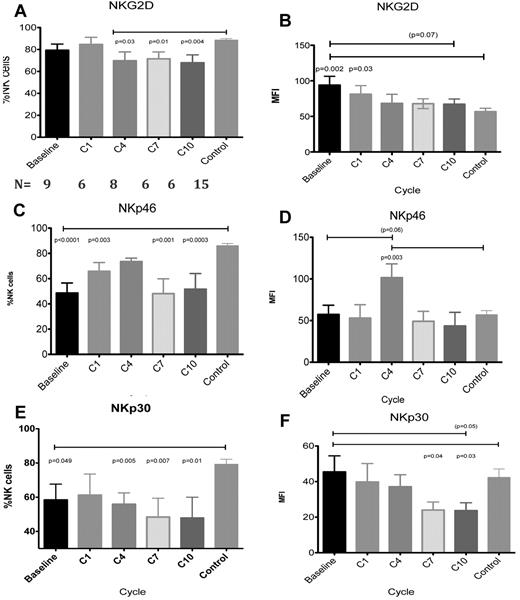To the editor:
We read with interest the recent article by Hsu et al1 that reported that the immunomodulatory properties of lenalidomide were lost when used in combination with dexamethasone in multiple myeloma patients. Specifically, they reported reduced natural killer (NK) activity caused by decreased levels of CD4 T cell–derived IL-2. Given the reported importance of NK cells in control of myeloma,2-4 this finding has obvious clinical implications.
To investigate the net immunomodulatory effect of combined dexamethasone/lenalidomide therapy,5 we audited innate immune status, as part of the routine laboratory support, for 29 myeloma patients although sequential data were only available for 9 patients. In particular we examined the expression of important natural killer cytotoxicity receptors NKp30 and NKp46 as well as NKG2D according to previously reported methods.6 Patients received lenalidomide 25mg/d in combination with a starting dose of 480mg/cycle (high dose) or 160mg/cycle (low dose) dexamethasone, the dose of dexamethasone being tapered after cycle 6. The absolute NK cell number nonsignificantly decreased over the 10 cycles analyzed (baseline 346 ± 76 cells/μL vs 196 ± 26 cells/μL at cycle 10; P = NS) although the relative frequency (variation from baseline) increased.
The report by Hsu et al assessed the expression of NK-cell receptors (DNAM, NKG2D, and NKp46) and showed, using in vitro–treated PBMCs obtained from healthy individuals, that dexamethasone reduced NK receptor levels and that expression could not be rescued by lenalidomide. We assessed the in vivo relevance of that finding using patient samples before and after treatment using relevant antibody panels and 3-color flow cytometry. The percentage of NK cells expressing NKG2D was similar in pretreatment samples to that seen in healthy controls (Figure 1A) but reduced during treatment. NKG2D receptor density assessed via mean channel intensity (MFI) was significantly higher than control values at baseline (P = .002) and throughout the early (C1) part of treatment (P = .03; Figure 1B) but reduced at later timepoints (C4-C10). The proportion of NK cells expressing NKp46 at baseline was significantly reduced compared with control values (P < .0001) but increased over the early part of treatment before falling again (cycles 7-10; Figure 1C). NKp46 receptor density was similar between patient and control samples except for a temporary rise noted at cycle 4 (Figure 1D). The reason for this temporary increase is unclear from this limited audit and any further comment would be speculation. The percentage of NK cells expressing NKp30 at baseline was significantly lower (P = .049) than in controls and expression was further reduced during treatment (Figure 1E). Baseline NKp30 receptor density was similar to control levels (Figure 1F) but reduced significantly during treatment.
The effect of combined treatment with dexamethasone and lenalidomide on natural killer–cell expression of NKp30, NKp46, and NKG2D in patients with myeloma. Serial blood samples were taken from myeloma patients before and during treatment with dexamethasone and lenalidomide as described in the text. Natural killer cell receptors were analyzed using a whole blood approach and flow cytometry. Results from NKG2D (A-B), NKp46 (C-D), and Nkp30 (E-F) are shown; in each case the percentage of NK cells positive for the receptor is shown as well as receptor density (assessed by mean channel fluorescence). In all cases, receptor expression is compared both between controls (n = 15, average age = 55) and patients (n = 9, average age = 63) and between patients before and during treatment.
The effect of combined treatment with dexamethasone and lenalidomide on natural killer–cell expression of NKp30, NKp46, and NKG2D in patients with myeloma. Serial blood samples were taken from myeloma patients before and during treatment with dexamethasone and lenalidomide as described in the text. Natural killer cell receptors were analyzed using a whole blood approach and flow cytometry. Results from NKG2D (A-B), NKp46 (C-D), and Nkp30 (E-F) are shown; in each case the percentage of NK cells positive for the receptor is shown as well as receptor density (assessed by mean channel fluorescence). In all cases, receptor expression is compared both between controls (n = 15, average age = 55) and patients (n = 9, average age = 63) and between patients before and during treatment.
These results add to the data presented by Hsu et al1 and others7 and demonstrate the effect of lenalidomide on activating NK cell–receptor expression in vivo in myeloma patients. We demonstrated that NK cells undergo a treatment-dependent reduction in NKC receptor expression although individual receptors were affected independently. This suggested that dexamethasone had a dominant inhibitory effect when used in combination with lenalidomide and confirmed that lenalidomide was unable to exert a positive immunomodulatory effect when used in conjunction with dexamethasone. The consequences for patients after this treatment were beyond the scope of this preliminary work but these results suggest that to obtain maximum benefit from this combination therapy, modified protocols may be required.
Authorship
Conflict-of-interest disclosure: G.C. has performed consultancy work for Celgene and Janssen. The remaining authors declare no competing financial interests.
Correspondence: Clive R. Carter, Leeds Teaching Hospitals NHS Trust, Dept of Immunology and Transplant Immunology, Level 09 Gledhow Wing, St James' University Hospital, Beckett Street, Leeds LS9 7TF, United Kingdom; e-mail: clive.carter@leedsth.nhs.uk.


This feature is available to Subscribers Only
Sign In or Create an Account Close Modal